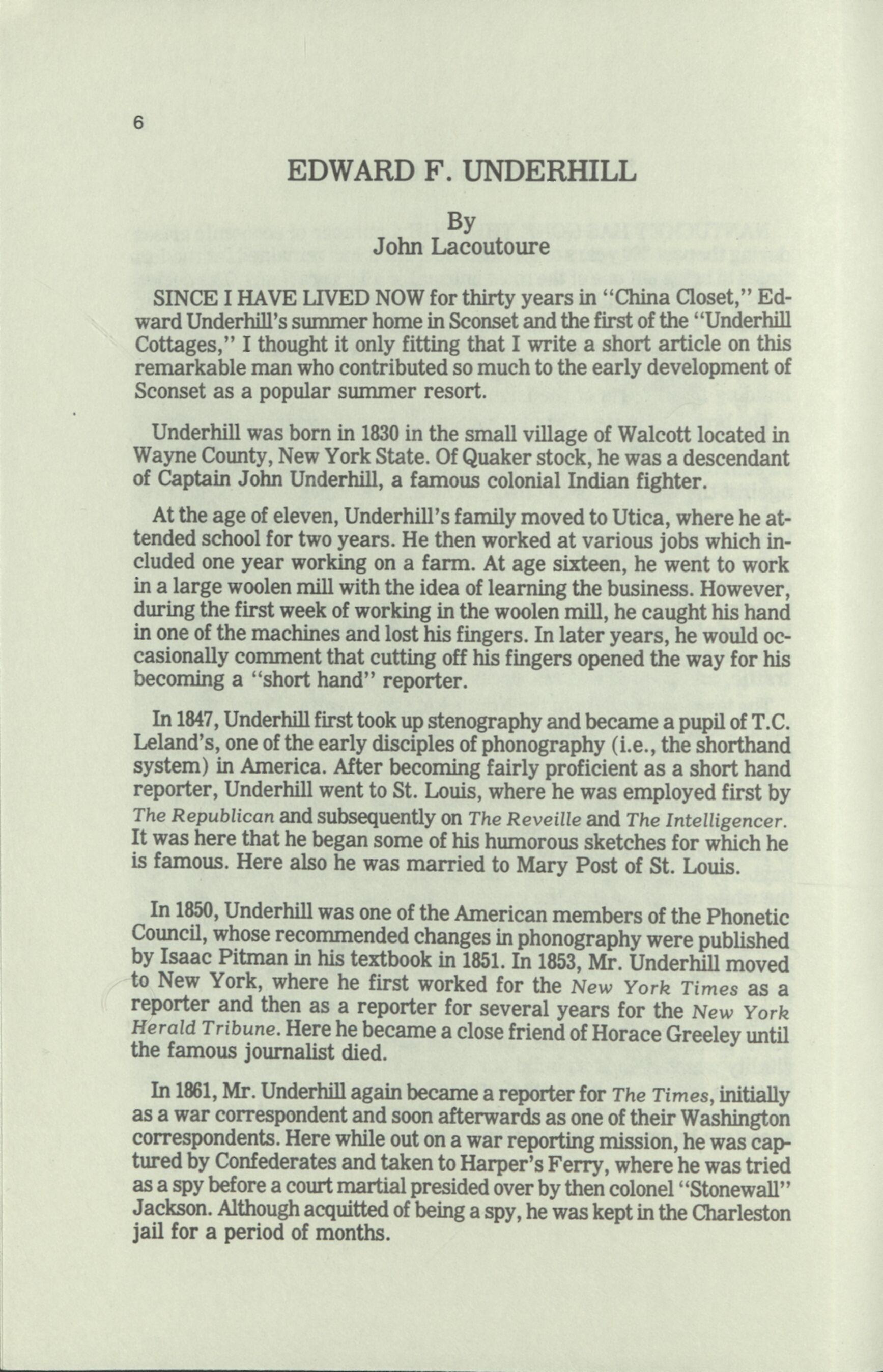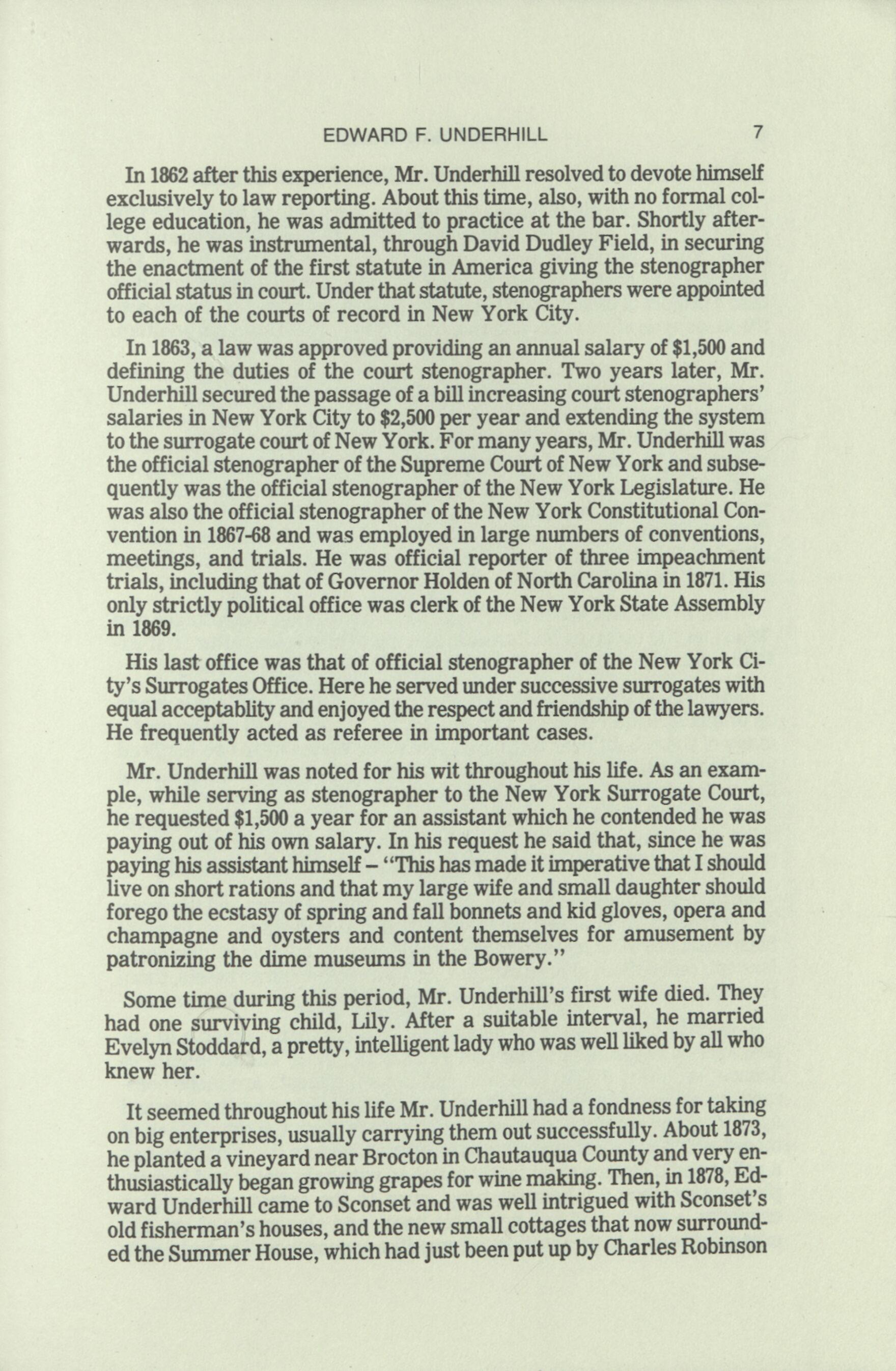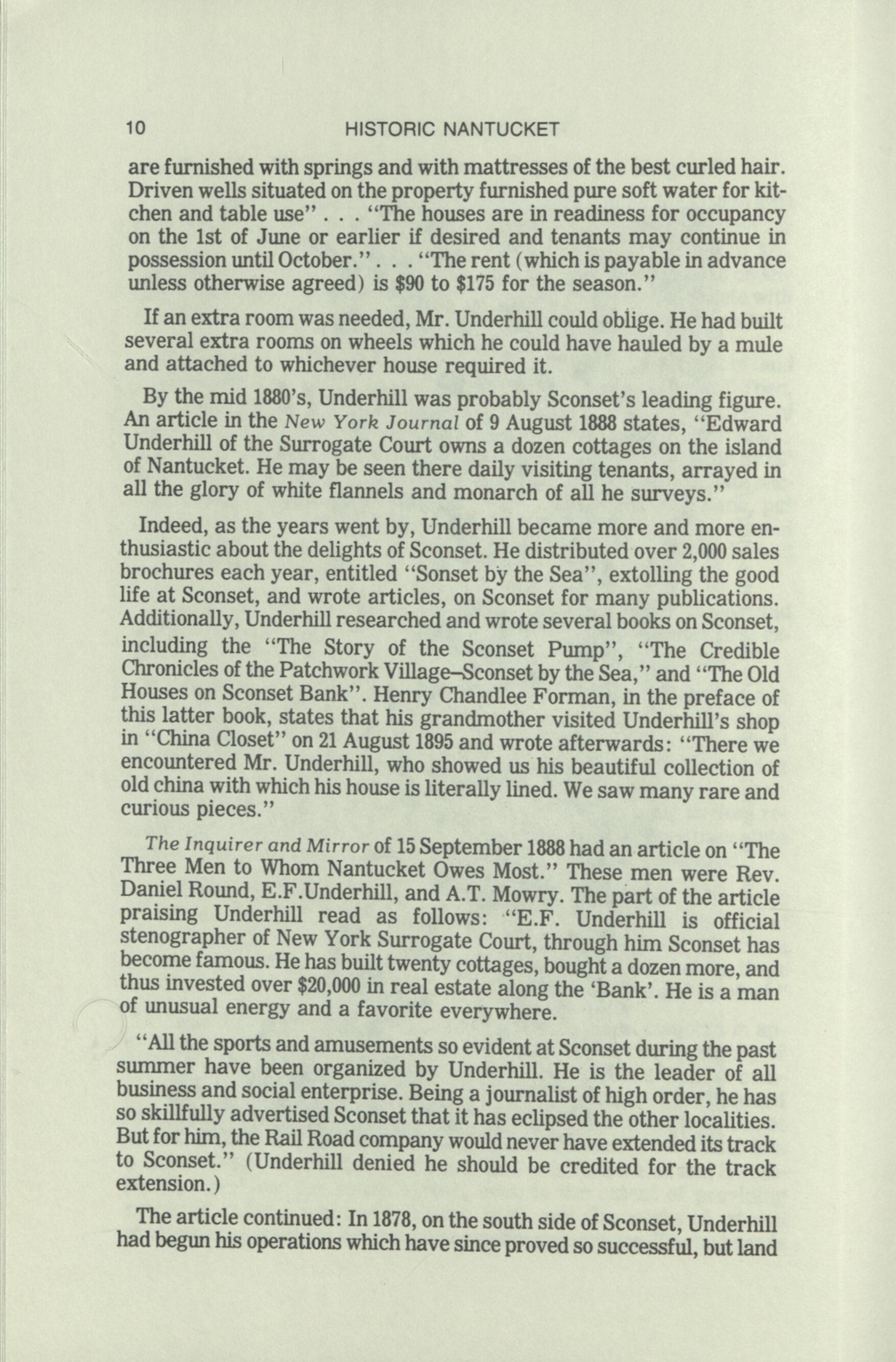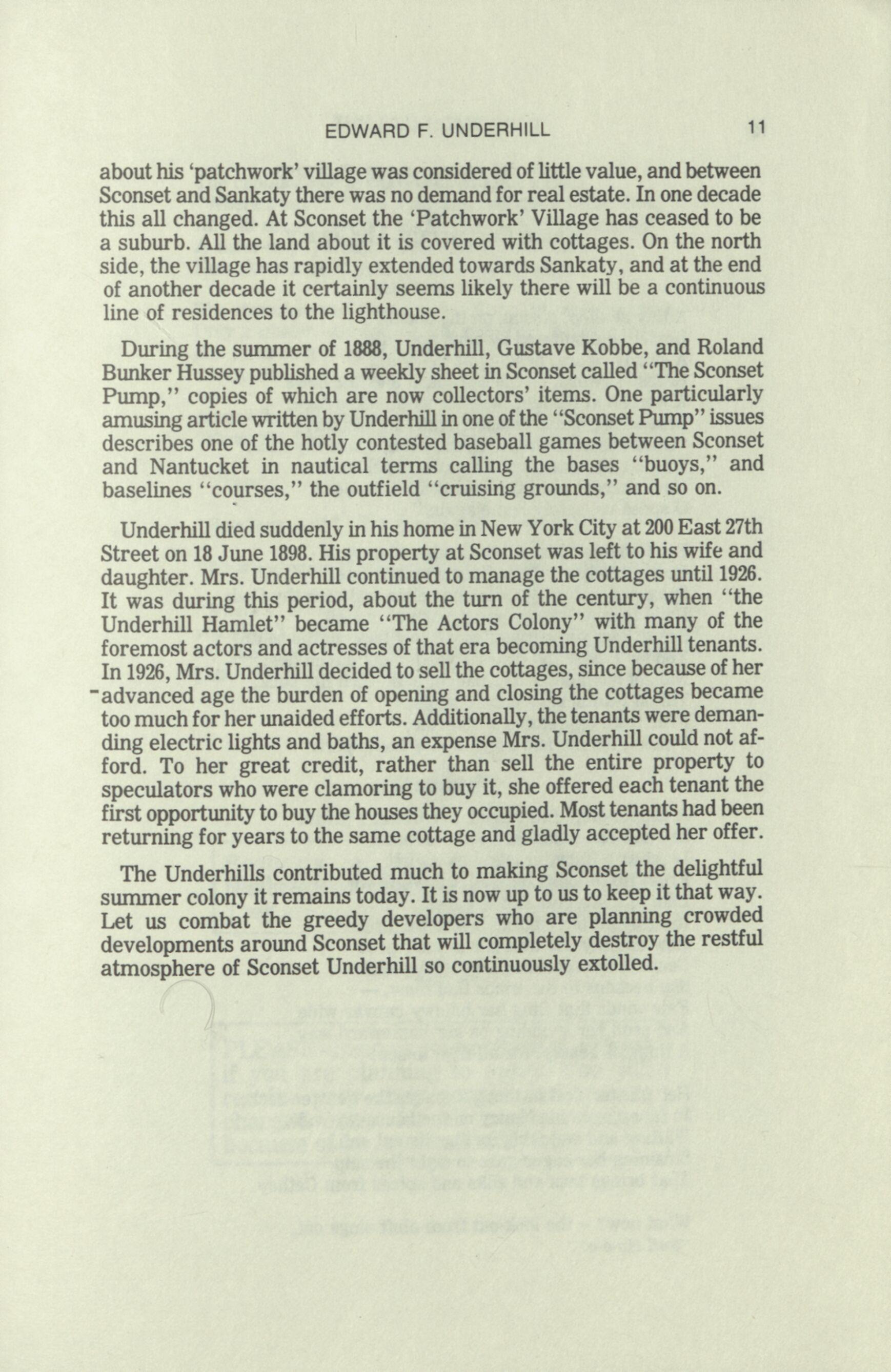
11 minute read
by John Lacouture
6
EDWARD F. UNDERHILL By
John Lacoutoure
SINCE I HAVE LIVED NOW for thirty years in "China Closet," Edward Underbill's summer home in Sconset and the first of the "Underhill Cottages," I thought it only fitting that I write a short article on this remarkable man who contributed so much to the early development of Sconset as a popular summer resort.
Underhill was born in 1830 in the small village of Walcott located in Wayne County, New York State. Of Quaker stock, he was a descendant of Captain John Underhill, a famous colonial Indian fighter.
At the age of eleven, Underbill's family moved to Utica, where he attended school for two years. He then worked at various jobs which included one year working on a farm. At age sixteen, he went to work in a large woolen mill with the idea of learning the business. However, during the first week of working in the woolen mill, he caught his hand in one of the machines and lost his fingers. In later years, he would occasionally comment that cutting off his fingers opened the way for his becoming a "short hand" reporter.
In 1847, Underhill first took up stenography and became a pupil of T.C. Leland's, one of the early disciples of phonography (i.e., the shorthand system) in America. After becoming fairly proficient as a short hand reporter, Underhill went to St. Louis, where he was employed first by
The Republican and subsequently on The Reveille and The Intelligencer. It was here that he began some of his humorous sketches for which he is famous. Here also he was married to Mary Post of St. Louis.
In 1850, Underhill was one of the American members of the Phonetic Council, whose recommended changes in phonography were published by Isaac Pitman in his textbook in 1851. In 1853, Mr. Underhill moved to New York, where he first worked for the New York Times as a reporter and then as a reporter for several years for the New York Herald Tribune. Here he became a close friend of Horace Greeley until the famous journalist died.
In 1861, Mr. Underhill again became a reporter for The Times, initially as a war correspondent and soon afterwards as one of their Washington correspondents. Here while out on a war reporting mission, he was captured by Confederates and taken to Harper's Ferry, where he was tried as a spy before a court martial presided over by then colonel "Stonewall" Jackson. Although acquitted of being a spy, he was kept in the Charleston jail for a period of months.
EDWARD F. UNDERHILL 7
In 1862 after this experience, Mr. Underhill resolved to devote himself exclusively to law reporting. About this time, also, with no formal college education, he was admitted to practice at the bar. Shortly afterwards, he was instrumental, through David Dudley Field, in securing the enactment of the first statute in America giving the stenographer official status in court. Under that statute, stenographers were appointed to each of the courts of record in New York City.
In 1863, a law was approved providing an annual salary of $1,500 and defining the duties of the court stenographer. Two years later, Mr. Underhill secured the passage of a bill increasing court stenographers' salaries in New York City to $2,500 per year and extending the system to the surrogate court of New York. For many years, Mr. Underhill was the official stenographer of the Supreme Court of New York and subsequently was the official stenographer of the New York Legislature. He was also the official stenographer of the New York Constitutional Convention in 1867-68 and was employed in large numbers of conventions, meetings, and trials. He was official reporter of three impeachment trials, including that of Governor Holden of North Carolina in 1871. His only strictly political office was clerk of the New York State Assembly in 1869.
His last office was that of official stenographer of the New York City's Surrogates Office. Here he served under successive surrogates with equal acceptablity and enjoyed the respect and friendship of the lawyers. He frequently acted as referee in important cases.
Mr. Underhill was noted for his wit throughout his life. As an example, while serving as stenographer to the New York Surrogate Court, he requested $1,500 a year for an assistant which he contended he was paying out of his own salary. In his request he said that, since he was paying his assistant himself - "This has made it imperative that I should live on short rations and that my large wife and small daughter should forego the ecstasy of spring and fall bonnets and kid gloves, opera and champagne and oysters and content themselves for amusement by patronizing the dime museums in the Bowery."
Some time during this period, Mr. Underbill's first wife died. They had one surviving child, Lily. After a suitable interval, he married Evelyn Stoddard, a pretty, intelligent lady who was well liked by all who knew her.

It seemed throughout his life Mr. Underhill had a fondness for taking on big enterprises, usually carrying them out successfully. About 1873, he planted a vineyard near Brocton in Chautauqua County and very enthusiastically began growing grapes for wine making. Then, in 1878, Edward Underhill came to Sconset and was well intrigued with Sconset s old fisherman's houses, and the new small cottages that now surrounded the Summer House, which had just been put up by Charles Robinson
8
HISTORIC NANTUCKET
and Franklin Ellis in a section then called "Sunset Heights."
At the time, the old fisherman's cottages were selling for $150 to $200 fully furnished, and even at those prices, there was little demand for them. These same cottages rented for the summer for $30 to $75. Underhill was captivated by the whole set-up and soon decided to undertake a project of building replicas of the fisherman's huts, complete with the same type of "warts" and roof lines, for rental to summer visitors.
With that in mind, he sold his grape industry and bought a plot of land on the South Bank and built a cottage for himself-"China Closet." Then, with increased enthusiasm for his dream village, he bought the rest of the land either side of Pochick St. and started building his fisherman's village replica cottages. All lots on Pochick Street were 52' wide by 60' deep, except for the two front lots. This project was an immediate success, so Underhill bought another plot of land off Morey's Lane, put through Evelyn Street, named after his wife, and Lily Street, named after his daughter, and began building additional cottages until he had a total of thirty-six cottages.
In one of his sales brochures, he includes pictures of the cottages and describes the cottages in dramatic and colorful fashion, after first extolling Siasconset's delightful location and climate and history.
In describing the old village cottages, he says, "the old village is made up of quaint little cottages, shingled on the sides as well as the roofs, many of them built over a hundred and some begun near two hundred years ago for the habitation of seafaring men engaged in fishing during the spring and fall, and whose ideas of house building seemed to have been gained from their experience on shipboard. The snug parlors remind one of ship cabins; the small bedrooms are little more than state rooms, while the closets are cabin lockers but slightly enlarged."
He than describes the Sconset location in glowing terms and the types of recreation available, concluding with "the resident visitors at Siasconset are of an intelligent, cultivated, and refined class, who come for rest, recreation, and retirement. As there are no large hotels, there is an absence of fashionable display, and with it real ease and comfort."
In describing his cottages, he states, "Most of them conform in appearance to the ancient fisherman's cottages" . . . "The simplicity of Sconset architecture is preserved, but the apartments are more commodious and a few accessories have been added to improve the outward appearance of the dwellings, without giving to them the ornate look of modern-built cottages at fashionable seaside resorts." . . . "Each has a cellar and a cistern abundantly supplied with rain water and is completely furnished for housekeeping, even to the extent of providing crockery, cutlery, and bed and table linen, and also works of art and ornament to give to the interiors a home-like appearance. The bedsteads


10
HISTORIC NANTUCKET are furnished with springs and with mattresses of the best curled hair.
Driven wells situated on the property furnished pure soft water for kitchen and table use" . . . "The houses are in readiness for occupancy on the 1st of June or earlier if desired and tenants may continue in possession until October." . . . "The rent (which is payable in advance unless otherwise agreed) is $90 to $175 for the season."
If an extra room was needed, Mr. Underbill could oblige. He had built several extra rooms on wheels which he could have hauled by a mule and attached to whichever house required it.
By the mid 1880's, Underhill was probably Sconset's leading figure. An article in the New York Journal of 9 August 1888 states, "Edward Underhill of the Surrogate Court owns a dozen cottages on the island of Nantucket. He may be seen there daily visiting tenants, arrayed in all the glory of white flannels and monarch of all he surveys."
Indeed, as the years went by, Underhill became more and more enthusiastic about the delights of Sconset. He distributed over 2,000 sales brochures each year, entitled "Sonset by the Sea", extolling the good life at Sconset, and wrote articles, on Sconset for many publications. Additionally, Underhill researched and wrote several books on Sconset, including the "The Story of the Sconset Pump", "The Credible Chronicles of the Patchwork Village-Sconset by the Sea," and "The Old Houses on Sconset Bank". Henry Chandlee Forman, in the preface of this latter book, states that his grandmother visited Underbill's shop in "China Closet" on 21 August 1895 and wrote afterwards: "There we encountered Mr. Underhill, who showed us his beautiful collection of old china with which his house is literally lined. We saw many rare and curious pieces."
T h e i n q u i r e r a n d M i r r o r of 15 September 1888 had an article on "The Three Men to Whom Nantucket Owes Most." These men were Rev. Daniel Round, E.F.Underhill, and A.T. Mowry. The part of the article praising Underhill read as follows: "E.F. Underhill is official stenographer of New York Surrogate Court, through him Sconset has become famous. He has built twenty cottages, bought a dozen more, and thus invested over $20,000 in real estate along the 'Bank'. He is a man of unusual energy and a favorite everywhere. "All the sports and amusements so evident at Sconset during the past summer have been organized by Underhill. He is the leader of all business and social enterprise. Being a journalist of high order, he has so skillfully advertised Sconset that it has eclipsed the other localities. But for him, the Rail Road company would never have extended its track to Sconset." (Underhill denied he should be credited for the track extension.)
The article continued: In 1878, on the south side of Sconset, Underhill had begun his operations which have since proved so successful, but land

EDWARD F. UNDERHILL
11
about his 'patchwork' village was considered of little value, and between Sconset and Sankaty there was no demand for real estate. In one decade this all changed. At Sconset the 'Patchwork' Village has ceased to be a suburb. All the land about it is covered with cottages. On the north side, the village has rapidly extended towards Sankaty, and at the end of another decade it certainly seems likely there will be a continuous line of residences to the lighthouse.
During the summer of 1888, Underhill, Gustave Kobbe, and Roland
Bunker Hussey published a weekly sheet in Sconset called "The Sconset
Pump," copies of which are now collectors' items. One particularly amusing article written by Underhill in one of the "Sconset Pump" issues describes one of the hotly contested baseball games between Sconset and Nantucket in nautical terms calling the bases "buoys," and baselines "courses," the outfield "cruising grounds," and so on.
Underhill died suddenly in his home in New York City at 200 East 27th Street on 18 June 1898. His property at Sconset was left to his wife and daughter. Mrs. Underhill continued to manage the cottages until 1926. It was during this period, about the turn of the century, when "the
Underhill Hamlet" became "The Actors Colony" with many of the foremost actors and actresses of that era becoming Underhill tenants.
In 1926, Mrs. Underhill decided to sell the cottages, since because of her "advanced age the burden of opening and closing the cottages became too much for her unaided efforts. Additionally, the tenants were demanding electric lights and baths, an expense Mrs. Underhill could not afford. To her great credit, rather than sell the entire property to speculators who were clamoring to buy it, she offered each tenant the first opportunity to buy the houses they occupied. Most tenants had been returning for years to the same cottage and gladly accepted her offer.
The Underhills contributed much to making Sconset the delightful summer colony it remains today. It is now up to us to keep it that way. Let us combat the greedy developers who are planning crowded developments around Sconset that will completely destroy the restful atmosphere of Sconset Underhill so continuously extolled.







